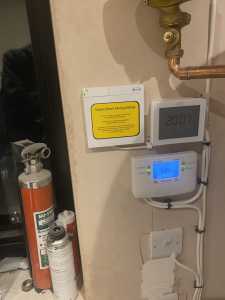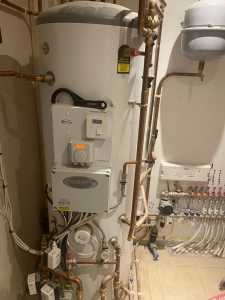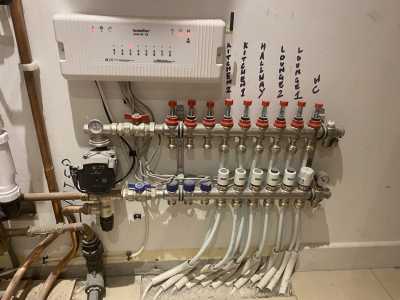Posted by: @oswiuI don't really understand your point. Yes they cycle more in warmer weather, but does anyone suggest turning the flow temp up to combat this? Or do you mean having boiler-style timings in spring/autumn but with low flow temperatures? I could see there being an argument for that.
Almost. I suggest that either
- setting the weather-compensation curve so that mild temperatures give a higher-than-minimum higher-than-needed flow temperature, with an old-fashioned on-off thermostat preventing overheating (so set to something like 20 or 21, rather than setting it to 29 or whatever is often advocated here); or
- having a cycling-detector shut the heat pump off for a while (an hour, perhaps) if it starts cycling - the heat built up in large radiators or underfloor heating will cover the shutdown time;
will be more efficient than running it with a flow temp that requires less than the minimum power output and letting the default cycling occur, which on a 5kW ecodan seems to shut off for as little as 5 minutes before resuming.
But, as I wrote, this probably won't be a problem for months now.
Posted by: @lucgwim very new to ashp - is this thermostat on the front of the cylinder. Ours is currently reading usually around 48/49 but does drop on its own accord to 44 at times.
That's almost certainly the domestic hot water (what comes out of the taps) temperature, but some pictures would probably help someone identify it for sure. Ours is usually 49 but drops as low as 13 when we're running out of hot water!
Do you have the controller manual for your heat pump? That should say how to change the (space heating) flow temperature. Alternatively, you might find videos on youtube demonstrating the process for your model.
We're currently getting through around 55kwH of electricity daily and November's bill was £515. We have an LG ASHP, solar PV and solar thermal. We've got cavity wall insulation, thick underfloor and loft insulation, double glazing and draught proofing, but it's still a 1950s bungalow. We've got the DHW temp at 45 degrees.
How do you change the flow temperature?
I'm dreading the price hike in January 2023 when Cornwall Insights are saying electricity is going to be £0.91/unit. According to last January's usage, that's going to cost us £2000. £2K! for a month!! Our annual consumption is around 10,000 kwH, so at this price around £833/month. When we first had the heat pump installed, it was £150-200/month.
I've just written to my MP to ask him about wholesale energy market reform. The electricity price is pegged to the gas price, despite the costs of renewable generation being so much lower. This needs government and policy intervention.
I'm dreading the price hike in January 2023 when Cornwall Insights are saying electricity is going to be £0.91/unit. According to last January's usage, that's going to cost us £2000. £2K! for a month!!Posted by: @pumpo-sorcerer
Is this for a domestic property? Unless there's something unique about your supply, this increase shouldn't actually affect you personally as the government will pay the difference. See this article https://www.moneysavingexpert.com/news/2022/11/energy-price-cap-to-rise---but-don-t-panic/
Thanks @oswiu - I hadn't clocked that the cap would still be in place in January. Sigh of relief breathed!
I think there's a case for more Ripple Energy style renewable energy co-operatives, especially now the on-shore wind farm ban has been lifted. However, the Grid needs to get its act together and get some batteries sorted out.
Posted by: @pumpo-sorcererHow do you change the flow temperature?
Look in the controller manuals for your heating system? There isn't a neat consistent method and it's often not as obvious as changing the target room temperature. It probably involves clicking around in the menus to adjust the weather compensation curve, if you've set that up as often advocated on here. If you're using an auto mode, there may be something in the Settings to limit the maximum flow temperature (also known as Leaving Water Temperature) it can use, but not on all systems (grrrr ecodan) and it will limit how quickly the system can warm the house up.
@lucgw Hi there, I'm relatively new to ASHP with a 10kW Grant Aerona3 ASHP and 250L pre-plumbed grant cylinder. I'm sitting at around 32-36kWh per day total electricity consumption to heat most of a 155m2 house to around 18degC. Deduct around 8kWh for non-ASHP consumption, so about 24-28kWh or 1-1.2kW per hour. OK, things I quickly learned:
1. Leave it running 24/7 on low, using weather compensation, with as many emitters open as you can in the rooms you want to heat. (I don't heat a spare bedroom, conservatory and an occasional room other than perhaps on demand, as heating unused rooms takes energy no matter what heating system you have.) Don't try to fire the AHSP on/off for a couple of times a day like a conventional boiler, it won't run efficiently. They are not designed to work that way even through many installers fit heating controls to ASHPs that are intended to do exactly that.
2. If you have a low loss header fitted, that's the grant rectangular white box with pipes to and from either side, check the flow on the ASHP primary side and secondary side are balanced. You can do this by checking the inlet and outlet temperatures on either side. The hotter supply pipes are at the top, and the cooler return pipes at the bottom. They should have comparable inlet and outlet temperatures. My installer had the ASHP primary pump flow set far too high with the pump in the ASHP on the maximum flow setting. That was sending heated water through the low loss header straight back to the ASHP. I've turned the ASHP pump to the minimum flow to be in much better balance with the secondary side flow and to avoid having to close the primary flow adjustment valve too much. A pump running at full speed against a half-closed flow setting valve is not efficient, but that was exactly what my installer did. See the Grant installation manual - pump speed is a simple dip switch adjustment inside the ASHP electrical enclosure.
3. Is weather compensation enabled? This needs checking at the Grant controller and requires a little knowledge of the controller settings and how to access stuff. It should be, but mine was left disabled by a Grant installer! Again, the Grant installation manual explains how to access and check this.
4. What's your maximum design heating temperature set to? Mine was 50degC but now is 45degC and is working fine with the bigger house radiators fitted. Lowering this will save a fortune in the long run. You can adjust the weather compensation setting min/max heating flow temperature coinciding with max/min outdoor air temperature. It's a bit of trial and error as every house has different requirements. The Grant default weather compensation settings isn't a bad start point, but if your installer has raised the heating flow temperature from Grant's 45degC default, that will raise the curve up as well. The key here is to get the flow temperature as low as you can, and have the heating on for as long as you can, i.e.: continuously.
5. Time your hot water to come on for 45 minutes a couple of times a day when the heating has been on an hour or so. It might not take that long, but the cylinder stat demand will satisfy and then revert to heating. That way, you're sending pre-warmed heating circuit water into the hot water cylinder. Trying to heat the hot water tank from a cold system start, or the house from a cold system start, uses a lot of electricity with the compressor running at high speed to pre-heat the system water volume. If you're heating is chugging away at, say 40degC supply, it's much more efficient to then switch over to hot water, which will probably need water at 55degC to satisfy at 50degC cylinder stat set point. Else you are raising water from about 20degC up to 55degC.
6. Make sure your main thermostat, which might be the Grant controller, but more likely is a room stat, is set to demand heating all the time. Control room temperatures using TRVs or programmable TRVs. Smart TRVs are not ideal, but they can be programmed to set back some rooms overnight as the Grant weather compensation is pretty simple and does not adjust for overnight set back without additional timers and controls fitted.
It is counter-intuitive to have the heating running all day, and especially all night. We're not used to that way of heating homes in the UK. Fired boilers can chuck large quantities of heat quickly into a space, ASHPs can't. Run them low and slow. The compressor will modulate down once you're at your weather compensation curve supply temperature set point and the return water temperature starts to rise up, and the power consumption per hour will drop. The compressor will switch off if the return water temperature gets too high. The compressor can modulate down to 20%, which is much lower than a gas boiler can. When the compressor re-starts from warm, it runs at high output speed for a few minutes before modulating down. When you start the system completely from cold, such as after being off for several hours, the compressor will run at high speed for and hour or two, and that will burn electricity. Also, running overnight in the cold weather will reduce the number of defrost cycles, the time the unit needs to defrost, and the energy required to do this. Defrost takes heat out of the water circuit, which can be quite quick and efficient when the circuit is up to temperature. But from a cold start it's a much slower process, which means your ASHP can struggle to get the water circuit up to temperature. It's fighting to stand still. The compressor will be cycling on and off but running at high speed whenever it is on. Again, that's consuming a lot of power to provide little space heating in the house.
Hope this all helps. The biggest problem with ASHP installs seems to be installers thinking ASHPs are simply replacement gas or oil boilers and giving customers very little information when they commission them. This forum is here to help!
Posted by: @mjrPosted by: @oswiuI don't really understand your point. Yes they cycle more in warmer weather, but does anyone suggest turning the flow temp up to combat this? Or do you mean having boiler-style timings in spring/autumn but with low flow temperatures? I could see there being an argument for that.
Almost. I suggest that either
- setting the weather-compensation curve so that mild temperatures give a higher-than-minimum higher-than-needed flow temperature, with an old-fashioned on-off thermostat preventing overheating (so set to something like 20 or 21, rather than setting it to 29 or whatever is often advocated here); or
- having a cycling-detector shut the heat pump off for a while (an hour, perhaps) if it starts cycling - the heat built up in large radiators or underfloor heating will cover the shutdown time;
will be more efficient than running it with a flow temp that requires less than the minimum power output and letting the default cycling occur, which on a 5kW ecodan seems to shut off for as little as 5 minutes before resuming.
But, as I wrote, this probably won't be a problem for months now.
Some heat pump controllers allow the on and off temperature variation from the calculated LWT to be changed, thereby allowing the difference between the switching on LWT and the switching off LWT to be increased or decreased. Increasing this difference in the milder weather may help reduce cycling.
Posted by: @pumpo-sorcererWe're currently getting through around 55kwH of electricity daily and November's bill was £515. We have an LG ASHP, solar PV and solar thermal. We've got cavity wall insulation, thick underfloor and loft insulation, double glazing and draught proofing, but it's still a 1950s bungalow. We've got the DHW temp at 45 degrees.
How do you change the flow temperature?
I'm dreading the price hike in January 2023 when Cornwall Insights are saying electricity is going to be £0.91/unit. According to last January's usage, that's going to cost us £2000. £2K! for a month!! Our annual consumption is around 10,000 kwH, so at this price around £833/month. When we first had the heat pump installed, it was £150-200/month.
I've just written to my MP to ask him about wholesale energy market reform. The electricity price is pegged to the gas price, despite the costs of renewable generation being so much lower. This needs government and policy intervention.
Well Pumpo Sorcerer, I think that you need a new 'book of spells' or you may lose your title.
Is your system not set to operate on weather compensation? If not, I suggest that you change to weather compensation mode. What is the size of your home and the required indoor temperature?
Posted by: @pumpo-sorcererThanks @oswiu - I hadn't clocked that the cap would still be in place in January. Sigh of relief breathed!
I think there's a case for more Ripple Energy style renewable energy co-operatives, especially now the on-shore wind farm ban has been lifted. However, the Grid needs to get its act together and get some batteries sorted out.
I'm afraid that National Grid cannot have any battery storage, since the present rules prevent NG from generating electricity. NG is therefore dependent upon private companies building battery storage systems, often not where they are of the most use, and then paying them to help balance the grid.
The consumer's of course end up paying in the end.
@allyfish thank you so much for all this information. I’m so jealous of your knowledge!
I am reading through and trying to digest it all.
I’ll drop you a message if I need a bit of clarification.
thank you! And thank you everyone else who has helped!
for those that asked to see a picture of the system - please see attached.
thank you
Currently viewing this topic 1 guest.
- 26 Forums
- 2,364 Topics
- 53.6 K Posts
- 203 Online
- 6,029 Members
Join Us!
Worth Watching
Latest Posts
-

RE: Octopus Cosy Heat Pump Owners & Discussion Thread
TC Thermostatic Radiator Valve TRV Plastic Decorators S...
By Toodles , 3 hours ago
-
RE: Ecodan unable to hit legionella target temp - what's the consensus?
UPDATE: Thanks everyone who commened with suggestions h...
By 9jwr9 , 8 hours ago
-
-
RE: ASHP sizing - value of Heat Transfer Coefficient
@toodles Hi, my friend recently made a video about heat...
By HeatPumpMe , 1 day ago
-

How long will your energy contract last?
Some heat pump tariffs don’t run as long as a heat pu...
By Toodles , 2 days ago
-

@morgan They are unsupervised these days, can’t get the...
By Toodles , 2 days ago
-
-

RE: Setback savings - fact or fiction?
Exactly. We only need to compare conditions, to decide ...
By cathodeRay , 3 days ago
-
RE: Balancing financial efficiency and comfort using the Octopus Cosy tariff
I found because I have very low heat loss I can set bac...
By RadWhisperer , 3 days ago
-
RE: Need Help Optimising My Rushed ECO4 Install: 12kW Bosch Heat Pump
Welcome @mickamills We too have an oversized 12kW Sa...
By Old_Scientist , 4 days ago
-
RE: My Powerwall 3 Consumes 3-4 kWh/Day in Self-Consumption: Is This Normal?
@caron I can confirm that the power usage of the PW3 is...
By Old_Scientist , 4 days ago
-
RE: Speedcomfort radiator fans
Thats true, but having tried (and succeeded) in constru...
By JamesPa , 4 days ago
-
RE: Solis S6-EH1P8K-L-PLUS – Why I Chose It and What I’ve Learned So Far
@bash brilliant, thanks for the feedback
By energy9165 , 4 days ago
-

RE: Heat Pump Heats the House… But It’s Not Cosy. Emitter Changes or System Tweak?
@alastair There I was, feeling grumpy, he said “Cheer u...
By Toodles , 4 days ago
-
RE: Grant Aerona: Is there a setting to keep the 2-port valve open during pump blockade
Depends on OAT. Mine cycles at OAT>10 and of course...
By JamesPa , 4 days ago
-
RE: New Fogstar 15.5kWh upright solution
@transparent My conclusion is as you have noted, tha...
By Bash , 4 days ago
-
RE: Mitsubishi Ecodan R290 10kW performance
And to you too. Wishing you a very enjoyable festive s...
By Sheriff Fatman , 4 days ago
-

RE: External pipework insulation
They do? But that isn't apparent from the photos we'r...
By Transparent , 4 days ago
-

RE: Say hello and introduce yourself
@velcro welcome to the forums. Please feel free start a...
By Mars , 5 days ago
-
Daikin EDLA11D3V3 DHW Settings
I have a newly installed EDLA11D3V3 which I'm still get...
By Velcro , 5 days ago








